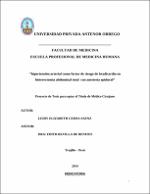Hipertensión arterial como factor de riesgo de bradicardia en histerectomía abdominal total con anestesia epidural

View/
Download
(application/pdf: 473.1Kb)
(application/pdf: 473.1Kb)
Date
2014Author(s)
Cerna Sáenz, Leidy Elizabeth
Metadata
Show full item recordAbstract
El presente estudio de cohortes tuvo como objetivos determinar sí la hipertensión arterial es un factor de riesgo para la aparición de bradicardia en pacientes sometidas a histerectomía abdominal total con anestesia epidural así mismo determinar la proporción de bradicardia en ambos grupos de pacientes y compararlos.
Se tomó una muestra representativa de 46 pacientes para cada grupo de estudio, sometidas a histerectomía abdominal total electiva, que ingresaron al Hospital Regional de Cajamarca en el año 2013, con edades entre 40 a 70 años, ASA I ó II, a las cuales se les administró anestesia epidural a ambos grupos. Se procedió a recolectar datos por medio de la ficha diseñada para el estudio, tanto en quirófano como en la Unidad de Recuperación Postanestesia (URPA); y posteriormente en hospitalización a la segunda y tercera hora del postoperatorio.
Los resultados muestran diferencias estadísticamente significativas (p < 0.001) entre ambos grupos de pacientes. Así mismo, se observó que existieron diferencias entre los porcentajes de ambos grupos y la aparición de bradicardia, así como en el análisis bivariado.
Se concluye que la hipertensión arterial es un factor de riesgo para desarrollar bradicardia en histerectomía abdominal total con anestesia epidural. This cohort study aimed to determine whether hypertension is a risk factor for the
occurrence of bradycardia in patients undergoing total abdominal hysterectomy with
epidural anesthesia and to determine the proportion of bradycardia in both groups of
patients and comparable. Tothis end we took are presentative sample of 63patients in each
group, under going surgery in elective total abdominal hysterectomy, who were admitted to
Hospital Regional de Cajamarca in year 2013, aged 40 to 70 years, ASA I or II, in whom
epidural anesthesia was administered to both groups. We proceeded to collect data through
the card designed to study bothin the operating roomand from thePost AnesthesiaRecovery
Unit(PACU) and subsequentl y in hospitalization at the second and thir dhour after surgery.
The results show statistically significant differences (p <0.001) between both groups of
patients. So, it was observed that there were differences between the percentages of both
groups and the appearance of bradycardia, and in the bivariate analysis.
We conclude that hypertension is a high risk factor to develop sinus bradycardia total
abdominal hysterectomy with epidural anesthesia.
Collections
- Medicina Humana [2969]

